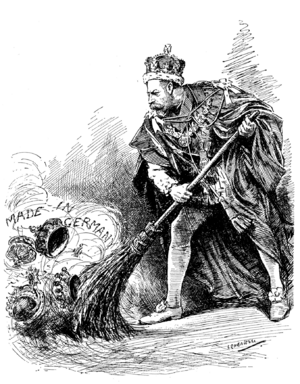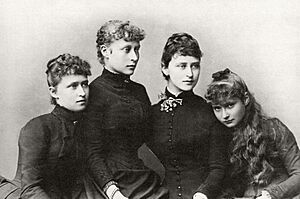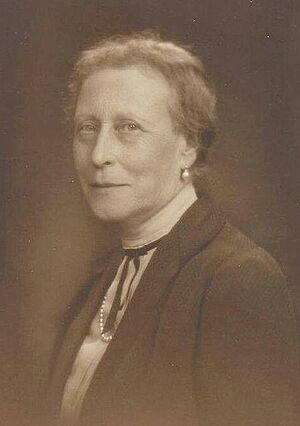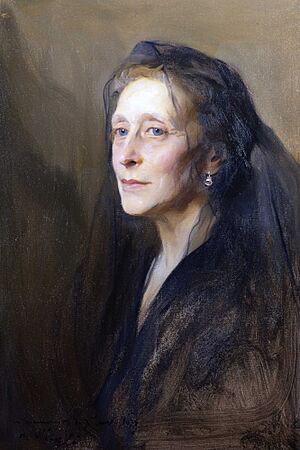Princess Victoria of Hesse and by Rhine facts for kids
Quick facts for kids Princess Victoria |
|||||
|---|---|---|---|---|---|
| Marchioness of Milford Haven | |||||

Portrait by Alexander Bassano, c. 1878
|
|||||
| Born | 5 April 1863 Windsor Castle, Windsor, Berkshire, England |
||||
| Died | 24 September 1950 (aged 87) Kensington Palace, London, England |
||||
| Burial | 28 September 1950 St Mildred's Church, Whippingham, Isle of Wight |
||||
| Spouse |
Louis Mountbatten, 1st Marquess of Milford Haven
(m. 1884; died 1921) |
||||
| Issue |
|
||||
|
|||||
| House | Hesse-Darmstadt | ||||
| Father | Louis IV, Grand Duke of Hesse and by Rhine | ||||
| Mother | Princess Alice of the United Kingdom | ||||
Princess Victoria of Hesse and by Rhine (born 5 April 1863 – died 24 September 1950) was a very important member of the British Royal Family. She was the oldest daughter of Louis IV, Grand Duke of Hesse and by Rhine. Her mother was Princess Alice of the United Kingdom, who was a daughter of Queen Victoria. This made Princess Victoria Queen Victoria's granddaughter.
Victoria was born at Windsor Castle in England. She grew up in both Germany and England. When her mother died, Victoria was still young, but she took on a lot of responsibility for her younger brothers and sisters. She married her cousin, Prince Louis of Battenberg, who was an officer in the British Royal Navy. Victoria lived in many different parts of Europe because of her husband's naval work. She was known for being smart, practical, and open-minded.
Victoria and Prince Louis had four children: Alice, Louise, George, and Louis. During World War I, Victoria and her husband changed their German family name to Mountbatten. This was a British version of their German name. Victoria's two sisters, Elisabeth and Alix, who had married into the Russian royal family, were sadly killed during the Russian Revolution. Later, her daughter Louise became the queen consort of Sweden. Her son Louis became the last viceroy of India. Victoria was also the grandmother of Prince Philip, Duke of Edinburgh, who was married to Queen Elizabeth II. This means she was the great-grandmother of King Charles III.
Contents
Early Life and Family
Victoria was born on Easter Sunday at Windsor Castle. Her grandmother, Queen Victoria, was there. She was christened in the Lutheran church. Her godparents included Queen Victoria and the future King Edward VII.
Victoria spent her early years in Darmstadt, Germany. She moved to the New Palace in Darmstadt when she was three. She shared a room with her younger sister, Elisabeth. Victoria received a very good education at home. She loved to read throughout her life.
When she was young, Victoria experienced wars. During the Austro-Prussian War in 1866, she and Elisabeth went to Britain to stay with their grandmother. During the Franco-Prussian War in 1870, she helped her mother in soup kitchens for soldiers. She remembered how cold it was and burning her arm with hot soup.
In 1872, Victoria's younger brother, Friedrich, was found to have haemophilia. This is a condition where blood does not clot properly. Sadly, the next year, Friedrich fell from a window and died. This was a very difficult time for the family.

In 1878, Victoria caught diphtheria, a serious illness. Her sister Elisabeth was moved away and did not get sick. Victoria's mother took care of the sick children. Sadly, her youngest sister, Marie, died. Soon after, her mother, Princess Alice, also became ill and died. This happened on the same day her father, Prince Albert of Saxe-Coburg and Gotha, had died many years before.
As the oldest child, Victoria took on a lot of responsibility. She helped care for her younger siblings and supported her father. She later wrote that her mother's death was a huge loss and that her childhood ended then.
Marriage and Family Life
Victoria often met Prince Louis of Battenberg at family gatherings. He was her cousin and worked as an officer in the Royal Navy. They met again in 1882 and decided to get married the next summer.
Victoria married Prince Louis on 30 April 1884. Her father did not fully approve because Prince Louis did not have much money. He also knew Victoria would live in Britain, far from him. But Victoria was strong-willed and did not let her father's feelings stop her.
Victoria and Prince Louis had four children over the next sixteen years:
| Name | Birth | Death | Marriage |
|---|---|---|---|
| Alice | 25 February 1885 | 5 December 1969 | Married 1903 Prince Andrew of Greece and Denmark They had five children, including Prince Philip, Duke of Edinburgh |
| Louise | 13 July 1889 | 7 March 1965 | Married 1923 King Gustaf VI Adolf of Sweden They had one stillborn daughter |
| George | 6 November 1892 | 8 April 1938 | Married 1916 Countess Nadejda Mikhailovna de Torby They had two children |
| Louis | 25 June 1900 | 27 August 1979 | Married 1922 Edwina Cynthia Annette Ashley They had two children |

They lived in different homes in England and Germany. When Prince Louis served in the navy, Victoria spent winters in Malta. In 1887, she got typhoid fever but recovered. She was interested in science and even drew a detailed map of Malta's geology. She also took part in archaeological digs. She kept careful notes of all the books she read, which showed her wide interests.
Victoria taught her own children and encouraged them to learn new things. Her youngest son, Louis, said she was like "a walking encyclopedia." She taught him to enjoy working hard and to be thorough. She was very open-minded and did not have prejudices.
Victoria was adventurous. In 1906, she flew in a Zeppelin airship. Later, she even flew in a biplane, which was very daring for the time. Before 1914, Victoria often visited her relatives in Germany and Russia. This included her two sisters, Elisabeth and Alix, who had married into the Russian royal family. Victoria tried to warn Alix about the influence of Rasputin, a controversial figure.
When World War I started in 1914, Victoria and her daughter Louise were in Russia. They had to travel a long way by train and ship to get back to Britain. They sailed on "the last ship" from Norway.
Later Life and Challenges

At the start of World War I, Prince Louis had to leave the navy because of his German background. Victoria and her husband moved to Kent House on the Isle of Wight. Victoria was upset about her husband's forced resignation.
In 1917, King George V of the United Kingdom gave up his German titles. At the same time, Prince Louis and Victoria also gave up their German titles. They took the surname Mountbatten, which was a British version of Battenberg. A few months later, the King made Louis a Marquess of Milford Haven.
During the war, Victoria's two sisters, Alix and Elisabeth, were killed in the Russian Revolution. Her brother, Ernest Louis, Grand Duke of Hesse, also lost his position. Victoria had visited the house where Alix would be killed just before the war. In 1921, Elisabeth's body was buried in Jerusalem, with Victoria present.
Victoria's husband died in London in September 1921. After his death, Victoria moved to Kensington Palace. She became a very important figure for the royal families of Europe. In 1930, her oldest daughter, Alice, became ill. Victoria then took on a big role in raising her grandson, Prince Philip. Prince Philip later said he liked his grandmother very much. He remembered her as practical and good with children.
More sadness followed in Victoria's life. In 1937, her brother Ernest Louis died. Soon after, her widowed sister-in-law, nephew, granddaughter, and two great-grandchildren died in a terrible plane crash in Ostend. Her granddaughter, Princess Cecilie of Greece and Denmark, and her family were all killed.
The next year, Victoria's son George died of bone cancer. Her granddaughter, Lady Pamela Hicks, remembered Victoria's tears. During World War II, Victoria's home at Kensington Palace was bombed. She stayed at Windsor Castle with King George VI. Her son Louis and two grandsons served in the Royal Navy. Her German relatives fought on the other side. She spent most of her time reading and worrying about her children. Her daughter Alice was in Greece and could not contact her mother for four years during the war.
After the war, her son Louis became Viscount Mountbatten of Burma. He was offered the job of Viceroy of India. Victoria was against him taking it because she knew it would be dangerous. But he accepted the job anyway.
On 15 December 1948, Victoria attended the christening of her great-grandson, Prince Charles. She was one of his eight godparents.
Victoria became ill in the summer of 1950. She had smoked since she was sixteen. She said "it is better to die at home" and moved back to Kensington Palace. She died there on 24 September 1950, at age 87. She was buried four days later at St. Mildred's Church, Whippingham on the Isle of Wight.
Legacy and Impact
Victoria wrote her life story with the help of her lady-in-waiting, Baroness Sophie Buxhoeveden. This book is now kept at the University of Southampton and is a valuable source for historians. Some of Queen Victoria's letters to Princess Victoria have also been published.
Her son, Lord Mountbatten, remembered her as very quick-witted, talkative, and smart. Her granddaughter thought she was "formidable, but never intimidating." She was seen as a very honest woman with a lot of common sense. Victoria wrote her own thoughts about her life near the end. She said that what truly matters in history is the good work done by individuals, not their titles. She also said she never thought she would be known only as her famous son's mother.
Honours and Awards
 Grand Duchy of Hesse: Dame of the Order of the Golden Lion, 1 January 1883
Grand Duchy of Hesse: Dame of the Order of the Golden Lion, 1 January 1883 Kingdom of Prussia: Red Cross Medal, 1st Class
Kingdom of Prussia: Red Cross Medal, 1st Class Russian Empire: Dame Grand Cross of the Order of St. Catherine
Russian Empire: Dame Grand Cross of the Order of St. Catherine United Kingdom:
United Kingdom:
- Queen Victoria Golden Jubilee Medal, 1887
- Royal Order of Victoria and Albert, 1st Class




